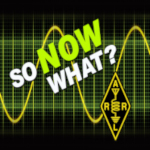Tag: ARRL
-

Attention New Hams !
If you’ve recently received a new license, or perhaps are returning to the hobby after some time, the ARRL has a new Podcast called “So Now What“ geared ‘just for you’. How cool is that? If you don’t know what a Podcast is think of it as “radio on demand” giving you an opportunity to…
-
HCRA is READY for Field Day – are YOU!
About seven days from now HCRA will be blasting the airwaves with “CQ Field” day from School St. Park in nearby Agawam, MA. Our plans have solidified to a 5A operation, perhaps even 6A, the usual superb four towers with beams on 40, 20, 15 and 10 and dipoles for 80/75. a Saturday VE session, lots…
-
New catagories for teh ARRL 10 meter and 160 meter contest.
This December’s ARRL 160 Meter and 10 Meter Contests complete the addition of new Single-Op Unlimited categories. All three power sub-categories: High Power, Low Power, and QRP are available. This means stations using spotting information will no longer be assigned to the Multioperator category. It also means there are quite a number of new records…
-
Homeland Security’s 2014 National Emergency Communications Plan Incorporates Amateur Radio
The Department of Homeland Security’s Office of Emergency Communications (DHS-OEC) has released the first updated National Emergency Communications Plan (NECP) since the original publication in 2008. According to the Department, the DHS-OEC developed the NECP in cooperation with more than 150 public and private sector emergency communications officials. Of interest to Amateur Radio Operators, is…
-
DX Bulletin 39
QST de W1AW DX Bulletin 39 ARLD039 From ARRL Headquarters Newington CT September 25, 2014 To all radio amateurs SB DX ARL ARLD039 ARLD039 DX news This week’s bulletin was made possible with information provided by HA3JB, ZL4PW, the OPDX Bulletin, 425 DX News, The Daily DX, DXNL, Contest Corral from QST and the ARRL…
-
Propagation Forecast Bulletin 24 ARLP024 From Tad Cook, K7RA Seattle, WA June 13, 2014
To all radio amateurs SB PROP ARL ARLP024 ARLP024 Propagation de K7RA Last week’s bulletin opened with your author (me) moaning about a decline in solar activity, but this was short lived. The current week saw average daily sunspot numbers more than double, rising from 60.1 to 144.3, and average daily solar flux rise from…
-
FCC Decides Not to Adopt New Rules Affecting 902-928 MHz Band
ARRL Bulletin 13 ARLB013 From ARRL Headquarters Newington CT June 12, 2014 To all radio amateurs SB QST ARL ARLB013 ARLB013 FCC Decides Not to Adopt New Rules Affecting 902-928 MHz Band The FCC has terminated a longstanding proceeding involving the 902-928 MHz (33 centimeter) band. In 2006, the FCC, in WT Docket 06-49, proposed…
-
Massachusetts to Host USA ARDF Championships June 5-8
The USA ARDF (Amateur Radio Direction Finding) Championships return to the Northeast this year. ARRL ARDF Coordinator Joe Moell, K0OV, said on-foot foxhunting fans of all skill levels will gather near Boston in early June for 4 days of intense competition. Registration to participate in the event has been extended to June 1. Activities begin…
-
Helpful DXlabs Tip #2156.572
Want to play in the ARRl Centennial QSO Party and work the W1AW/? stations? Every week they are in two different states. It’s easy using SpotCollettor. Simply program one of the eight SQL buttons to do the hard work for you. Never done it before, here’s an example using the “SQL 1” button: 1. Hold…
